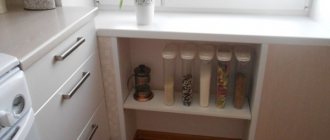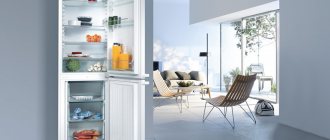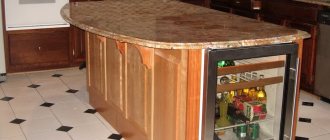Khrushchev's apartments are still relevant in the real estate market: buying such an apartment is often very profitable, since their prices are very affordable. Residents of Khrushchev-era apartments, and realtors, know one feature of these apartments: the so-called refrigerator under the window, which was built in during the construction of the house. Modern designers have come up with many options for transforming this usable area, which will be discussed further.
Refrigerator under the window under the tree
Refrigerator under the window with wooden doors
The history of Khrushchev's kitchen window sills
During the construction of Khrushchev houses, household appliances were an expensive rarity. Not every family could buy a good refrigerator right away. In addition, the available models were very large and were not suitable for small-sized kitchens in Khrushchev’s new buildings.
Refrigerator under the window under the kitchen unit
Plasterboard shelves under the window
Engineers found a solution: a refrigerator under the window in a Khrushchev building. For that time it was an ideal solution, although it had its own characteristics. Kitchens in Khrushchev were perfect for this design; in winter, in the part where the refrigerator was located, it was cold enough to store food.
Refrigerator under the window
Storing workpieces under the window
After some time, household appliances became more accessible to the population, manufacturers began to produce smaller models, and the need for a built-in refrigerator disappeared. But the niche in the wall remains, and residents of Khrushchev’s apartments often have the question of what to do with this interior element. There are two options: repair the opening and use it as a refrigerator or kitchen cabinet with a reduced temperature, or remake the Khrushchev refrigerator and use it for other purposes.
Refrigerator box under the window
Sink under the kitchen window
“Khrushchev refrigerator” in the kitchen: elimination, replacement, improvement, alternatives
Many will agree that in the modern world such sophistications are no longer needed, or at least require some modification to fit into modern interiors.
Although they are called “Khrushchev’s”, they were also found in the so-called Stalinists. Actually, in any such apartment the layout does not allow for ample space for everything you need in a small kitchen. And as an option, you can use the cabinet space under the window sill for more practical tasks.
And most importantly, it is clearly necessary to do something with thermal insulation, because now everyone already understands that the better the house is insulated, the lower the cost of heating it will be. However, not everything is so simple with the possibility of remaking or improving the Khrushchev refrigerator.
It is important to take into account a number of very important points that many DIYers often forget about. For the sake of order, let's consider modification options that can be applied to the Khrushchev refrigerator and explain the especially important points in the implementation of the chosen method
It is quite reasonable to assume four options:
For the sake of order, let's consider modification options that can be applied to the Khrushchev refrigerator and explain the especially important points in the implementation of the chosen method. It is quite reasonable to assume four options:
- Completely or mostly seal the space under the window sill. This will ensure decent and high-quality thermal insulation. As a result, the wall will be leveled or a small recess will remain, sufficient for installing a heating radiator.
- Modify and properly insulate the Khrushchev refrigerator in order to use it for its intended purpose and store food and pickles in it. Even with the fact that no significant alterations are required, a lot still needs to be done in order not to leave any chance for the cold to penetrate inside the apartment and not have a bunch of negative consequences.
- This niche can be completely reoriented, for example, into a cabinet or as a place to install equipment that is unpretentious to low temperatures.
- Dismantle the thin half-brick partition to the outside and glaze it in the style of a French window. The most radical solution. Perfect for cases where the kitchen window faces either the north side, or is blocked from sunlight by buildings or trees, the amount of daylight entering through such a window will more than cover the disadvantage.
Option one: finishing a Khrushchev refrigerator
The main disadvantage of space under the window is open ventilation and condensation. And modern repair and decoration of the refrigerator under the window, respectively, have the following goals:
- make the temperature difference on the walls less;
- keep the temperature under the windowsill low;
- make this element of kitchen design as aesthetically pleasing as possible.
There are two ways to maintain the desired temperature and eliminate condensation: using moisture-resistant and thermally insulating building materials or installing closed ventilation. Coolers and air conditioners for such a small space are difficult to find and installation will require significant costs. The easiest way is to insert a small fan into the ventilation hole: it will not only allow cold air to pass through, but will also prevent it from stagnating in a small space.
Niche under the window in the kitchen
Refrigerator trim under the window
However, it is even easier to insulate the external wall and use thermal insulating materials for finishing: plastic, polystyrene foam, polystyrene foam, polyethylene foam. Tile retains the cold best, but condensation forms on it, so finishing with tiles will require the use of special thermal insulating additives in glue or cement, and ventilation must be of very high quality. As insulation, you can use mineral, glass or foam wool, thermal insulating concrete or the same polyethylene foam.
It is important to completely prevent the exchange of air between the refrigerator and the kitchen; to do this, you need to make tightly fitting doors. Ordinary wooden ones are not very suitable - they need to be adjusted very precisely so that there is no heat leakage. Doors made of plexiglass or plastic would be ideal. Sliding metal and plastic double-glazed windows are also hermetically sealed, which can be made to order from companies involved in glazing apartments and balconies.
However, the glass in such doors will cool greatly and reduce the air temperature in the kitchen. To avoid this, you need to order double insulated glass units or replace the glass in them with transparent plastic.
Remodeling a refrigerator under the window
Refrigerator under the window with plastic doors
Sequence of work
When performing insulation with your own hands, you should adhere to the following sequence:
- Completely free the niche. Remove shelves and mountings for them.
- Clean the surface from old insulation or paint.
- Clean the ventilation hole and install a louvered metal grille on it (with the ability to regulate the flow of outside air).
- Plaster the surface of the walls.
- Prime the dried surface with acrylic primer for walls 2 times (with an interval of 3-4 hours).
- Make a hole in a sheet of penotex cut to size, located opposite the hole in the back wall of the refrigerator. The hole should be cut in a cone shape, with the narrow end facing the street. The resulting cone should be equipped with a loop handle and used to regulate the flow of cold air in severe frosts;
- Using adhesive mastic (“liquid nails”), stick a sheet of penotex 30-40 mm thick onto the back wall of the refrigerator.
- Cover the upper (under the window sill) wall with penotex.
- Glue a sheet of penofol insulation with a thickness of 3-10 mm on top of the penotex. also cover the side walls, ceiling and floor of the refrigerator with penofol (the thickness of the penofol does not play a significant role, its main function is screen).
- Glue all joints between penofol with foil tape.
At this point, the finishing of the interior space of the refrigerator under the window is completed.
Option two: cold cabinet
Since almost no one needs a refrigerator with open ventilation and cooling nowadays, the opening under the windows can be converted into a kitchen cabinet. In this case, ventilation is no longer needed - the hole can be sealed with polyurethane foam or concreted. The outer wall can be left uninsulated if condensation is weak on it, or thin insulation with high thermal insulation and moisture-resistant properties can be used.
Refrigerator under the window with lighting
To reduce the likelihood of condensation, the doors should be made airtight, as in the case of a refrigerator. If you order double-glazed doors, you can make lighting inside the cabinet; it will be practical and beautiful, especially if the glass is made translucent or stained glass. You can also use mirrors instead of glass: such doors have little practical value, but this option will visually increase the space of a small kitchen.
An alternative to doors can be a cabinet with drawers - this is no less practical, but this option will reduce the thermal insulation of the opening, since it is quite difficult to select hermetically sealed drawers.
Shelf instead of a refrigerator under the window
Selection criteria
First you need to decide on the type of refrigerator:
- without a freezer - very rarely used in apartments. They are more often found in dachas and recreation areas - in places where there is no need for long-term storage, and it is enough to maintain the freshness of food for 1-2 days;
- single-chamber - fairly compact models, suitable for small-sized kitchens in Khrushchev-era buildings. Also, such units are preferred by people who rarely eat at home;
- two-chamber is the most common option. Relatively compact, but quite roomy;
- Side - by - side - two-door refrigerator with a separate freezer. Due to its large size it is suitable only for large kitchens. If the family is large and the kitchen is small, then such models are most often installed in another room: corridor, hallway, living room, dressing room;
- French Door - in size and functionality it can compete with the Side-by-side model. The only significant difference is the absence of an internal partition between the doors, which increases the volume of internal space. The disadvantage of the French Door model can be considered the worst thermal insulation performance, due to the fact that in the middle the doors are adjacent only to each other, and not to the body;
- free-standing modules (wine cabinet for a bar counter, freezer, etc.) - depending on the purpose and manufacturer, the dimensions of such models can vary greatly. Very often, individual modules, just like side-by-side models, are installed not in the kitchen, but in other rooms.
One of the most important factors when choosing a refrigerator is its cost. It depends not only on the brand name and country of origin, but also on a number of general parameters.
Control type
Controlling a refrigerator is the process of setting the required mode and temperature. During normal operation, the settings are changed very rarely, but they do change. For example, they set the economy mode during vacation, etc.
There are two types of management:
- mechanical;
- electronic.
Manual models are usually cheaper, but less functional. Most often they are installed in houses where power surges regularly occur, or where the power is often turned off. The mechanics are more resistant to such situations.
Models with mechanical controls are also preferred by people of the older generation - they are closer and more familiar with it than modern electronics.
Electronic control, in turn, is much more convenient to use. Therefore, if there are no problems with electricity, or finances allow you to install an uninterruptible power supply or an emergency relay (as protection against power surges), then preference is given to models with electronic control.
Defrost type
Ice accumulating on the walls of the freezer leads to increased energy consumption and excessive load on the refrigerator. Therefore, all models require regular defrosting.
There are three ways to defrost a refrigerator:
- Manual.
- Drip (semi-automatic).
- No frost (fully automatic).
The manual method is considered obsolete, therefore it is practically not used in modern technology. Only in the most budget models, and even then, you still need to look for them.
The drip method is considered the successor to the manual defrosting method. The ice in the refrigerator compartment is removed on its own and flows drop by drop into the pan (hence the name). The freezer must be defrosted manually, because the drip method does not work at subzero temperatures.
No frost - fully automatic method. The refrigerator itself solves its problems without interfering with a person and without even informing him of his needs. All liquid is collected in a special pan, from which it is used for the cooling system. It turns out to be a kind of fully automated closed cycle. No frost is the most convenient, modern, but also the most expensive of all existing defrosting systems.
Technical specifications
The most important part of a refrigerator is the compressor. It depends on it how long and efficiently the refrigerator will perform its functions. The compressor can be linear or inverter.
Linear ones are time-tested classics, while inverter ones are more modern devices. They are more expensive, but inverter compressors are more economical and operate quieter.
There are also combined models. Externally, they are no different from ordinary ones, but are equipped with several compressors, each of which maintains the temperature and microclimate in a separate chamber.
Efficiency class
Depending on the amount of energy consumed, all models are divided into several classes:
- A+, A++, A+++ - the most economical models of the latest generation.
- A, B, C - economical models.
- D - intermediate class.
- E, F, G - devices with increased energy consumption.
In addition to the energy saving class, other parameters will also affect energy consumption. For example, the ambient temperature or the frequency of door opening.
Design
Separately, it is worth noting convenient design solutions that make the operation of the refrigerator more comfortable, but increase its cost:
- freshness zone. Different manufacturers call it differently: Fresh Box, Flex Cool or Fresh Zone, but the essence of the zone is the same - maintaining a temperature close to 0 °C. Depending on the model, the freshness zone can be made in the form of a separate box or a separate chamber. In some cases, there may be several freshness zones for different products. In this case, they differ from each other in the humidity maintained in each chamber;
- mini bar. It can be made in the form of an independent section with a separate door, or have the form of a free-standing small block. The presence of a minibar makes the refrigerator more expensive, but helps save money during operation. Products for frequent use are placed in it: drinks, yoghurts, curds. In this case, the main door of the refrigerator has to be opened less often, and, therefore, there is no need to waste extra energy maintaining the desired temperature in the main chamber;
- transparent door. In order not to create the effect of a store display, manufacturers make doors that become transparent only on demand (when you press the touch panel or when you knock on the door). This option allows you to see the contents without opening the door and letting out the precious cold;
- fastenings on the doors. To make it easier to fit a refrigerator into a kitchen set, some manufacturers of built-in appliances equip the doors with special fastenings for the facades. This approach simplifies the process of installing and decorating the refrigerator;
- compressor on top. This feature is due to the need for hidden equipment for additional cooling. With this design, it is much easier to use an additional ventilation window in the headset, or to connect an additional cooling system.
Option three: heating radiator
If apartment owners are most concerned about the temperature in the kitchen, they should avoid using the opening for storing food or kitchen utensils. Instead, the opening can be completely or partially sealed and a second heating radiator can be built in or a larger one can be installed. To fill the opening, you will have to carefully lay the brick, then plaster and putty well. It may be necessary to replace the window sill.
Radiator instead of refrigerator under the window
Option four: fireplace
Many people dream of having a real fireplace in their home, and the opening under the windows in a Khrushchev-era building allows them to fulfill their dream. The outer wall of the opening will also have to be insulated and finished with materials with low electrical conductivity and moisture resistance - and you can put an electric fireplace there that imitates a real fire.
Refrigerator under the window with sliding doors
But if what is more important is not the appearance of the electric heater, but its power, then you can build an oil heater or a stone quartz heating panel into the opening. But it is not recommended to use reflectors and fan heaters in the opening - they require free air exchange, which will not be available in such a small space.
This kitchen design will require the creation of proper electrical wiring and grounding.
Radiator grill under the kitchen window
Advantages and disadvantages
Before installing a refrigerator in a niche in the kitchen, you need to look at what the pros and cons of this solution are.
Having studied the photos in the interior, such a kitchen design will not seem rational or practical to everyone. Let me disagree.
For objectivity, let's take a look at the strengths and weaknesses.
First, as I like, about the benefits. They are like this here:
- External attractiveness
. In terms of appearance, the kitchen benefits from the presence of a niche; - Practicality
. You can make shelves and drawers on the sides, as well as above the refrigerator. This increases the capacity of the kitchen; - Reducing noise levels
. In practice, it has been proven that the niche reduces the noise emanating from the refrigerator compressor; - Protection from external influences
. Since only the front side is open, the refrigerator gets less dust, dirt, and sunlight; - Rational use of space
. Especially relevant for small kitchens.
But this is one side of the coin.
Before you hide the refrigerator in a niche in the kitchen, consider the existing disadvantages.
The disadvantages include the following points:
- Additional financial costs
. A niche costs money. Even if you do it yourself. Therefore, the total cost of repairs will increase; - Higher energy consumption
. Devices that have improved thermal insulation and an additional cooling element are usually chosen for a niche. And they need more electricity to work; - Loss of space
. Partitions must have certain dimensions that exceed the dimensions of the equipment. Therefore, in miniature kitchens of about 5-6 square meters, such a solution will have to be abandoned.
If the kitchen area is 8 square meters or more, then placing a refrigerator in a niche in the kitchen will be more than realistic. The usable space will not suffer much.
Option five: washing
The sink in a small kitchen takes up a lot of space. This becomes even more problematic if residents need a dishwasher. And the opening under the windows will save usable space. To wash by a window, you will need to redesign the sewer and water pipes and replace the window sill to install a sink there. To finish the opening you will need moisture-resistant materials and insulation to avoid condensation on the walls and pipes.
To install a dishwasher, you will need to change the kitchen electrical circuit. In the same way, you can install a washing machine under the window.
Cabinet under the kitchen window
Option six: French window
The window opening in the Khrushchev kitchen is very small and provides little light, especially if the apartment is located on the north side of the house. In this case, natural light can be increased using a French window. The main difficulty lies in dismantling part of the outer wall. For such work, not only qualified construction specialists are needed, but also official technical permission for redevelopment.
Refrigerator under the window with glass shelves
A French window can be complemented with a classic balcony: it does not require a special concrete platform, it is very narrow and is built into the wall. But you can also get permission for a modern French balcony, which requires a concrete platform no more than half a meter wide. Such a platform can also be partially built into the wall. The railings for such balconies are usually made of wrought iron and are very beautiful.
Refrigerator under the window with glass doors
From the above we can conclude that even a refrigerator under the window in a Khrushchev apartment can be used if you approach this issue wisely. There are many options for using it, the main thing is to choose yours.
Instructions for installing a built-in refrigerator in a kitchen set
When performing work, we follow the following sequence of actions:
- We dismantle old equipment, if relevant. We try to work extremely carefully and carefully.
- We remove the purchased device from the packaging and remove the transport fasteners. It should be noted that when choosing the appropriate device, we must take into account the dimensions of the cabinet and the location of the fastening elements.
- We carefully inspect the device, then carry out a test run. We pay attention to how the motor works and check the functionality of the internal circuitry of the device.
- Pay attention to the direction in which the cabinet doors open. If practical, install the hinges on the desired side.
- We move the unit to its intended place, ensure vertical installation by changing the position of the adjusting elements located at the bottom of the product. It is advisable to use a building level for this purpose.
- To ensure a fixed position of the device, we use special foam pads and carefully select the required thickness. It is advisable to place them near the rear of the unit.
- We install the facade part and all the provided mounting elements. We check the smoothness of door opening, stability and reliability of the structure.
- We connect the unit to the electrical network and make sure it is fully operational.
It is recommended to perform the work if you have certain skills. If they are not there, then it is better to contact specialists who will competently and promptly perform all the actions. Otherwise, the work may result in complete failure and significant financial losses.











